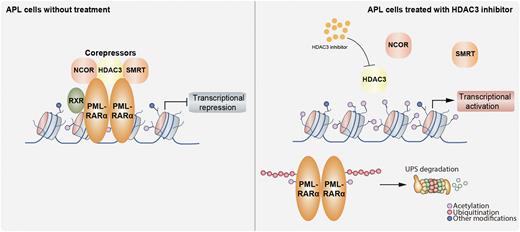Abstract
Acute promyelocytic leukemia (APL) is driven by the oncoprotein PML-RARα, which recruits corepressor complexes, including histone deacetylases (HDACs), to suppress cell differentiation and promote APL initiation. All-trans retinoic acid (ATRA) combined with arsenic trioxide (ATO) or chemotherapy highly improves the prognosis of APL patients. However, refractoriness to ATRA and ATO may occur, which leads to relapsed disease in a group of patients. In this study, we obtained the relationship between different HDACs with APL by analyzing transcriptional dataset of leukemia and confirmed the positive association of HDAC3 with PML-RARα in the mRNA and protein levels measured in primary human APL blasts. Experiments in vitro indicated that targeting HDAC3 but not HDAC1 or HDAC2 induced more effective differentiation and apoptosis in both NB4 cells and primary human APL cells. To examine the effects of HDAC3 inhibition on APL cells in vivo, we utilized normal FVB mice transplanted with APL cells from hMRP8-PML-RARα transgenic mice and NB4 or NB4-HDAC3Cas9 xenograft mouse model. We found that pharmacological or genetically inhibition of HDAC3 extended the survival rate of mice and alleviated spleen infiltration of leukemia cells and promoted the apoptosis and differentiation of APL cells. As to the molecular mechanism, we first examined whether HDAC3 affected PML-RARα expression level and the results demonstrated that HDAC3 inhibition reduced PML-RARα protein half-life rather than transcriptional activity via the ubiquitin proteasome system. In the subsequent experiments, we constructed a series of PML-RARα mutations. By confocal imaging system, acetylation and protein-protein interaction assays, we demonstrated that HDAC3 directly bound to the LBD and DBD domains of RARA protein and modulated the acetylation of lysine 394 of PML, which reduced PIAS1-mediated PML-RARα SUMOylation and subsequent RNF4-induced ubiquitylation. HDAC3 inhibition induced an increase of K394 acetylation, and promoted PML-RARα ubiquitylation and subsequent degradation, while the effect could be rescued by proteosome inhibition. Our results further revealed that the inhibition of HDAC3 induced degradation of both wild-type and ATRA- or ATO-resistant mutant PML-RARα (A216V, L218P, ΔF286 and R276Q). Therefore, we speculated that targeting HDAC3 could induce antileukemic effects on ATO- or ATRA-resistant APL cells. In NB4-R1, NB4-R2 and primary human APL cells, inhibition of HDAC3 increased significantly the cell differentiation and apoptosis, decreased PML-RARα expression and reduced the proliferation and colony-formation units (CFUs). For experiments in vivo, ATRA-resistant APL xenograft mouse model of NB4-R2 cells and patient-derived tumor xenograft (PDX) model were utilized to evaluate the effects of targeting HDAC3. Results showed that targeting HDAC3 extended the survival of mice, decreased the leukemia cells infiltration and increased the differentiation and apoptotic cells. In conclusion, our study identifies the role of HDAC3 as a positive regulator of the PML-RARα oncoprotein by deacetylating PML-RARα and suggests that targeting HDAC3 could be a promising strategy to treat relapsed/refractory APL.
Disclosures
No relevant conflicts of interest to declare.
Author notes
Asterisk with author names denotes non-ASH members.


This feature is available to Subscribers Only
Sign In or Create an Account Close Modal